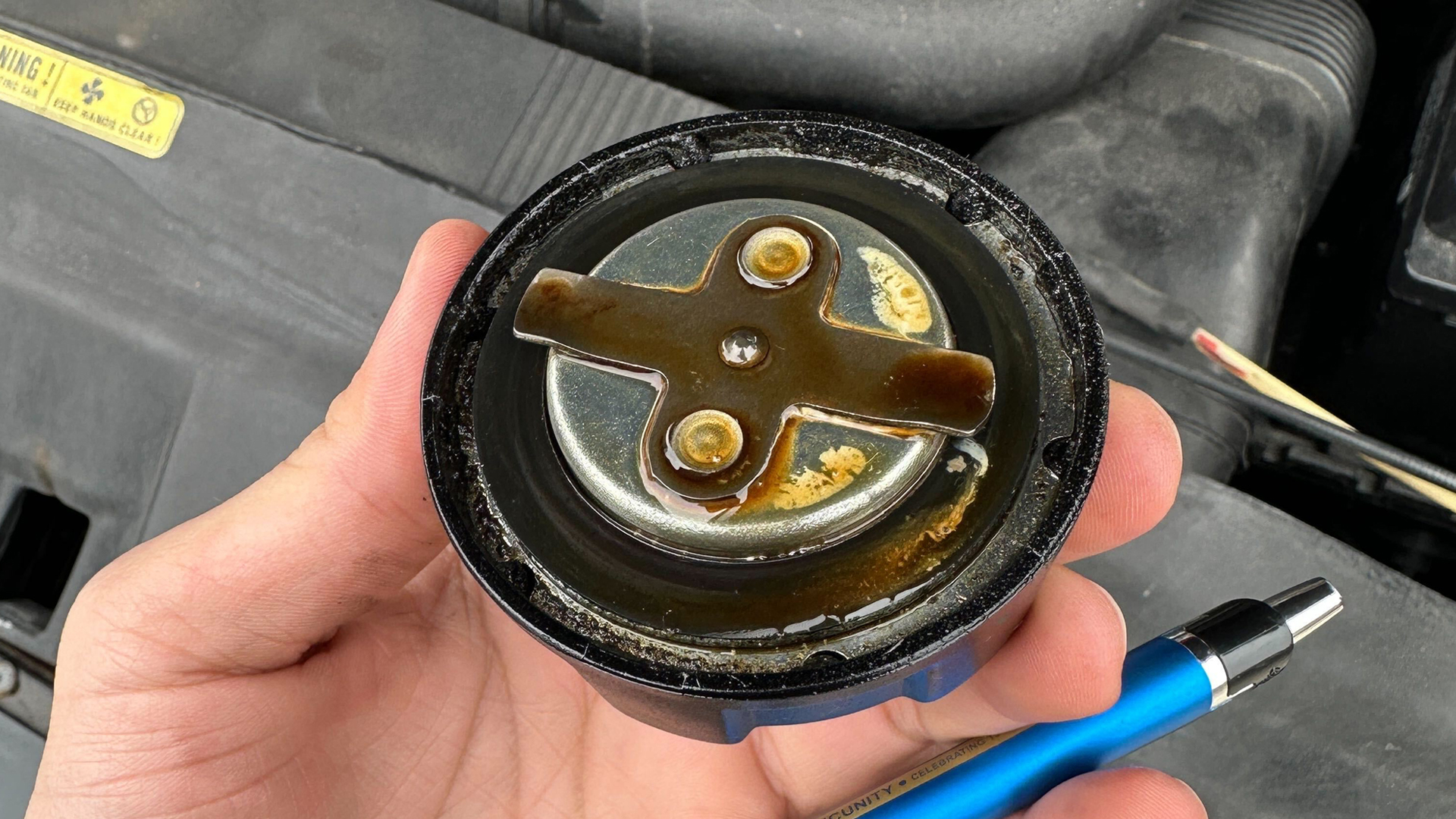

We may earn revenue from the products available on this page and participate in affiliate programs. Learn more ›
Whenever you’re inspecting a used car, you should always pop the oil cap and inspect it for milky residue on the underside. This white substance can indicate how the vehicle’s been cared for and if there’s a potentially serious problem with the engine. But checking the oil cap for residue shouldn’t be reserved for judging whether or not a used car’s worth buying. It should be a part of your vehicle’s maintenance schedule. Knowing what it is, what it can indicate, and, most importantly, what your next move should be is essential in ensuring a long and healthy life for your car.
So, what is that milky residue underneath your oil cap? Let me explain.
What Is the Milky Residue?
The milky residue on an engine cap is the product of engine oil mixing with water or moisture. It’s that simple. But your engine oil cap should create an airtight seal. If your vehicle is healthy, water should never mix your oil to the extent that it would produce this residue.
To understand whether you’ve got a major or minor mechanical issue on your hands, you need to determine what’s causing the oil to mix with water.
You’re Not Driving Enough
Yes, the oil cap makes an airtight seal, but changes in ambient temperature and humidity attract moisture from the air to the metal in the engine. This happens in all vehicles, and it’s not usually a problem, as the moisture evaporates when your engine is up to running temperatures.
The problem is that some of us don’t drive our vehicles at normal operating temperatures for long enough. So the moisture in the engine never evaporates and instead condenses on the metal and drips into the oil pan. If your trips are usually five to ten minutes long, chances are this is what’s causing water to mix with your oil.
Thankfully, this was what was causing the residue build-up in Kay’s Porsche 911. I say “thankfully” because, luckily for him, the remedy is more time behind the wheel.

Damaged Oil Cap
Your oil cap is designed to keep air, water, and all other contaminants out of your oil. If the cap’s seal is broken, moisture will get into your oil pan and continue to contaminate it until you fix the cap.
High-Pressure Washing
When you take pride in your vehicle, not much beats giving it a good clean with a high-pressure power washer. And a clean engine bay is even more satisfying. But high-pressure power washers and engine bays do not mix, or at least they shouldn’t.
High-pressure power washers can force water into parts of the engine that it shouldn’t. If you spray high-pressure water at any of these areas, it could lead to water contaminating your oil: oil cap, air filter housing, power steering cap, and the engine oil dipstick. It’s best to use low-pressure water spray to clean your engine bay and avoid spraying any engine seals.
Blown Head Gasket
A blown head gasket is the major mechanical issue I hinted at toward the beginning of this article. If the milky substance on your oil cap is the result of a blown head gasket, it could spell big trouble.
Your vehicle’s head gasket creates an airtight seal between the cylinders and the engine block, ensuring maximum compression. It also prevents engine coolant and oil from entering the cylinders. If your head gasket is damaged or blown, engine coolant can leak into the passages for the oil and mix with it, which results in a milky oil cap.
If left untreated, a blown head gasket can damage the cylinder heads and bearings and crack the engine block. Ultimately, you’ll face a hefty repair bill or might need to replace the engine.

How To Check if Your Head Gasket Is Blown
Since a blown head gasket could put a sizable dent in your bank account, you need to determine if it’s the source of your problems quickly. A simple way to check is to get your engine up to its normal running temperature and inspect your engine oil dipstick. If there are beads of moisture on the dipstick, your head gasket might be damaged.
There are a few other indicators of head gasket damage. If coolant is leaking into the vehicle’s cylinders, it’ll produce white smoke from the exhaust, so look out for this. Coolant could leak below the exhaust manifold, and there might be bubbles in the coolant overflow tank or radiator. And since you’re losing coolant, you might notice that your engine is running hot or overheating.
What To Do
Firstly, rule out all the minor mechanical issues. Check your oil cap to make sure it has a good seal. If you’re not already doing so, start taking your car for longer rides at highway speeds. And if you’re cleaning your engine bay with high-pressure water, stop.
If you’ve ruled out all the minor mechanical problems and it looks like your car’s head gasket is damaged, it’s time to bring your vehicle to a mechanic. Head gasket sealers may work temporarily, but shouldn’t be treated as a permanent fix. Ultimately, the gasket will need to be replaced.
Video
Since a blown head gasket is the thing we’re worried about in this situation, check out FordTechMakuloco’s video on how to diagnose a blown head gasket.

More From The Drive
- The new Dodge Charger might get a Hemi after all…
- These are the best EDC deals of the week, you need to jump on them
- Ford’s Godzilla motor belts out 984 horsepower, all natural
- Get a handle on trouble codes with TopDon’s Artidiag Pro scan tool
- What the heck is dielectric grease anyway?